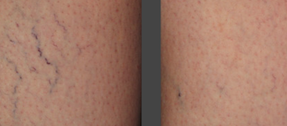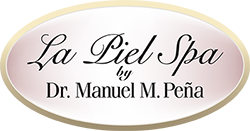 Millions of women are bothered by spider veins – those small yet unsightly clusters of red, blue or purple veins that most commonly appear on the thighs, calves and ankles. In fact, it’s estimated that at least half of the adult female population is affected by this common cosmetic problem. Asclera® Sclerotherapy is a common treatment for small (spider veins) and medium size (reticular) veins. A tiny needle is used to inject the veins with a solution (called a sclerosant) that irritates the lining of the vein. In response, the veins collapse and are reabsorbed. The surface veins are no longer visible. Depending on the size and location of the veins, different types and strengths of sclerosants are used. With this procedure, veins can be dealt with at an early stage, helping to prevent further complications.
Millions of women are bothered by spider veins – those small yet unsightly clusters of red, blue or purple veins that most commonly appear on the thighs, calves and ankles. In fact, it’s estimated that at least half of the adult female population is affected by this common cosmetic problem. Asclera® Sclerotherapy is a common treatment for small (spider veins) and medium size (reticular) veins. A tiny needle is used to inject the veins with a solution (called a sclerosant) that irritates the lining of the vein. In response, the veins collapse and are reabsorbed. The surface veins are no longer visible. Depending on the size and location of the veins, different types and strengths of sclerosants are used. With this procedure, veins can be dealt with at an early stage, helping to prevent further complications.
FAQ’s:
How Does Asclera® Sclerotherapy work?
Asclera® is a sclerosing agent that is injected into the vein. It works by damaging the endothelium, the cells lining the inside of blood vessels. This causes blood platelets and cellular debris to attach to the lining of the vessels; eventually, cellular debris and platelets cause the blood vessel to clot. Over time, the clotted vein will be replaced with tissue.
What are spider veins?
Spider veins are very small and very fine red or blue veins. They are closer to the surface of the skin than varicose veins. They can look like a thin red line, tree branches or spider webs. Spider veins can be found on the legs and face and may cover a small or large area.
What are reticular veins?
Reticular veins can also be known as feeder veins. They are the blue and green veins beneath the surface of the skin.
Reticular veins enlarge because of increased pressure in the vein. They can be caused by heredity. You may have reticular veins alone but you may also have spider veins at the same time.
What causes spider and reticular veins?
Spider and reticular veins can be caused by many factors.
Heredity. Having a family member with prominent veins may increase the risk of you developing them. Approximately half of the people who get varicose veins have a family history of them.
Age. The normal wear and tear of aging may cause valves in the veins to weaken and not work as well.
Gender. Women are two to three times more likely to develop varicose veins than men. Up to half of American women have varicose veins. Changes in hormones due to puberty, pregnancy, menopause, or taking birth control pills may increase a woman’s risk of developing varicose veins.
Pregnancy. During pregnancy, the growth of the fetus increases the pressure on the veins in the legs. Varicose veins that occur during pregnancy usually improve within 3 to 12 months following delivery.
Overweight and obesity. Having extra weight on the body can put additional pressure on the veins.
Prolonged standing or sitting. This is particularly true with legs bent or crossed. When standing or sitting with legs bent or crossed, the veins have to work harder to pump the blood up to the heart.
How many Asclera® Sclerotherapy treatments are required?
It varies from individual to individual but typically 2-4 treatments are required for the best results. In patients with milder cases, 1-2 will suffice. The treatments are more when there are more veins or slightly larger veins. You may need anywhere from one to several sclerotherapy sessions for any vein region. Depending on the type and number of veins being treated you may have one or several injections per session.
How long is the recovery?
The procedure usually causes only minimal discomfort. Generally, no “recovery” time is needed after sclerotherapy, and patients can resume their regular activities immediately.
Can Asclera® Sclerotherapy be used to treat large varicose veins?
Unfortunately, Asclera® Sclerotherapy is generally used for the very small superficial veins next to the skin. Sclerotherapy is not effective for large veins and requires large amounts of the sclerosants with the potential to be absorbed. When large veins are treated with sclerotherapy, a stronger solution and a higher volume is required. Following the treatment for larger veins, compression hose stockings are usually recommended to be worn for at least 2 weeks. It is best to get spider veins treated in the winter months as one can easily wear stockings.
Do I have to limit any activity after the treatment?
Walking is highly recommended soon after the procedure. But any high activity sports should be avoided for the first 2-3 days.
Can Asclera® Sclerotherapy be done on the arms or face?
No, absolutely not. Asclera® Sclerotherapy should never be done on the face and hands. The hand veins may not look pretty at times, but they should never be treated. Even though veins on the face are being done with sclerotherapy, the injections can be painful and the results are variable. If the facial veins are very conspicuous, laser is a better option than sclerotherapy.
Is there any harm in removing spider veins?
Spider veins have no function and removing does no harm. The only reason they are removed is because of their unsightly cosmetic.
Can anyone undergo Asclera® Sclerotherapy?
Almost anyone with unwanted spider veins can be treated, except women who are pregnant or nursing. Other relative contraindications include those with skin infections, uncontrolled diabetes, fever, history of deep vein thrombosis, anticoagulant therapy those patients taking corticosteroids.
Is there any preparation required before Asclera® Sclerotherapy?
No preparation is required before the procedure. It is recommended that one stop smoking and stop taking aspirin a few day before the procedure. Any patient on a blood thinker is not a candidate for sclerotherapy.
